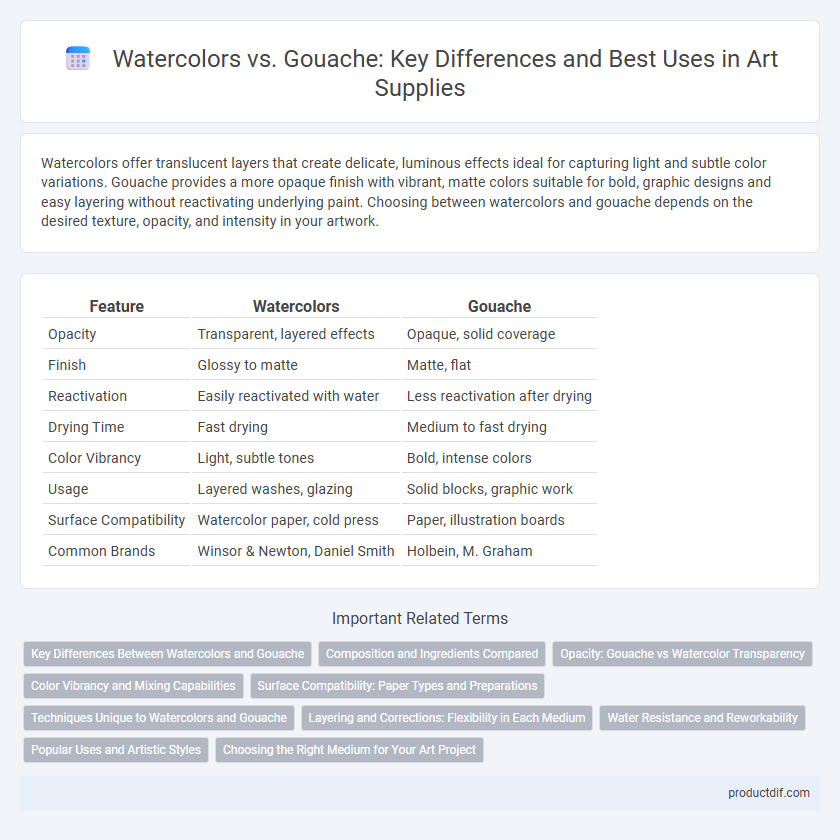Watercolors offer translucent layers that create delicate, luminous effects ideal for capturing light and subtle color variations. Gouache provides a more opaque finish with vibrant, matte colors suitable for bold, graphic designs and easy layering without reactivating underlying paint. Choosing between watercolors and gouache depends on the desired texture, opacity, and intensity in your artwork.
Table of Comparison
| Feature | Watercolors | Gouache |
|---|---|---|
| Opacity | Transparent, layered effects | Opaque, solid coverage |
| Finish | Glossy to matte | Matte, flat |
| Reactivation | Easily reactivated with water | Less reactivation after drying |
| Drying Time | Fast drying | Medium to fast drying |
| Color Vibrancy | Light, subtle tones | Bold, intense colors |
| Usage | Layered washes, glazing | Solid blocks, graphic work |
| Surface Compatibility | Watercolor paper, cold press | Paper, illustration boards |
| Common Brands | Winsor & Newton, Daniel Smith | Holbein, M. Graham |
Key Differences Between Watercolors and Gouache
Watercolors are transparent and allow light to pass through, creating a luminous effect, while gouache is opaque, offering solid, vibrant color coverage. Watercolors typically require layering for intensity, whereas gouache can be applied in thick, flat washes or detailed highlights. The difference in opacity and texture makes gouache more versatile for bold artwork, while watercolors excel in delicate, translucent designs.
Composition and Ingredients Compared
Watercolors consist of pigments suspended in a water-soluble binder, typically gum arabic, resulting in a transparent finish ideal for layering and light washes. Gouache contains similar pigments but with added chalk or white pigment, producing an opaque, matte surface that covers underlying layers completely. The presence of these fillers in gouache affects its composition, making it heavier and less luminous compared to the clear, vibrant transparency characteristic of watercolor paints.
Opacity: Gouache vs Watercolor Transparency
Gouache offers a rich, opaque finish, allowing artists to layer colors easily without previous layers showing through, unlike watercolor which is translucent and relies on the paper's whiteness for its luminosity. This opacity makes gouache particularly suited for illustrations, lettering, and opaque color blocks, whereas watercolor excels in creating delicate washes and gradients with visible underlying textures. Understanding the transparency differences helps artists choose the right medium for achieving either vibrant, solid coverage or subtle, glowing effects.
Color Vibrancy and Mixing Capabilities
Watercolors offer translucent layers that enhance subtle color vibrancy, allowing light to reflect through pigment for delicate effects. Gouache provides opaque coverage with richer, more saturated colors that maintain intensity even when layered. Mixing watercolors yields soft gradients and transparency variations, while gouache blends deliver bold, matte finishes with excellent reworkability for precise color control.
Surface Compatibility: Paper Types and Preparations
Watercolors perform best on lightweight, textured papers such as cold-pressed or rough watercolor paper, which allow for smooth pigment absorption and delicate color layering. Gouache requires heavier, less absorbent surfaces like hot-pressed watercolor paper or illustration board to maintain its opacity and prevent warping. Proper surface preparation, including stretching or priming, enhances pigment adherence and prevents buckling, ensuring optimal results for each medium.
Techniques Unique to Watercolors and Gouache
Watercolors require mastering wet-on-wet techniques to achieve soft blending and transparent layering effects that emphasize light and fluidity. Gouache techniques involve opaque layering and dry brushing, enabling vibrant, matte finishes and greater control over texture and detail. Both mediums offer diverse textural possibilities, but watercolors excel in luminosity while gouache provides bold color opacity.
Layering and Corrections: Flexibility in Each Medium
Watercolors offer translucent layering that allows subtle color build-up and easy lifting for corrections, making them ideal for delicate adjustments. Gouache provides opaque layers that cover previous strokes completely, enabling bold corrections and reworking without affecting underlying colors. Both mediums present unique flexibility in layering and corrections, with watercolors favoring gradual transparency and gouache supporting solid, reworkable coverage.
Water Resistance and Reworkability
Watercolors offer limited water resistance, making them highly reworkable for blending and lifting colors even after drying. Gouache, while opaque and vibrant, provides moderate water resistance once dry, allowing artists to achieve flat washes but with less flexibility for reworking without reactivating previous layers. Both mediums cater to different techniques, with watercolors excelling in fluidity and gradual tonal shifts, and gouache favored for bold, matte finishes and layering effects.
Popular Uses and Artistic Styles
Watercolors are favored for their transparency and fluidity, making them ideal for landscapes, botanical illustrations, and delicate washes in impressionistic and realist styles. Gouache, with its opaque and vibrant qualities, suits graphic design, illustration, and bold, solid-color artworks often seen in poster art and modern expressionism. Artists choose watercolors for subtle layering effects, while gouache is preferred for intense color blocking and detailed, matte finishes.
Choosing the Right Medium for Your Art Project
Watercolors offer transparency and subtle blending, making them ideal for delicate washes and layering effects in landscapes or portraits. Gouache provides opaque coverage and vibrant colors, perfect for bold designs, illustrations, and graphic work requiring solid color blocks. Selecting between watercolors and gouache depends on the desired finish, texture, and intensity of color for your specific art project.
Watercolors vs Gouache Infographic

 productdif.com
productdif.com